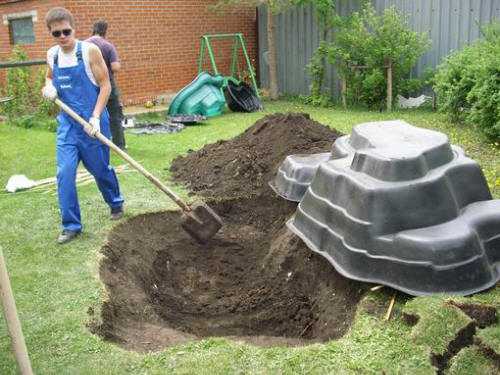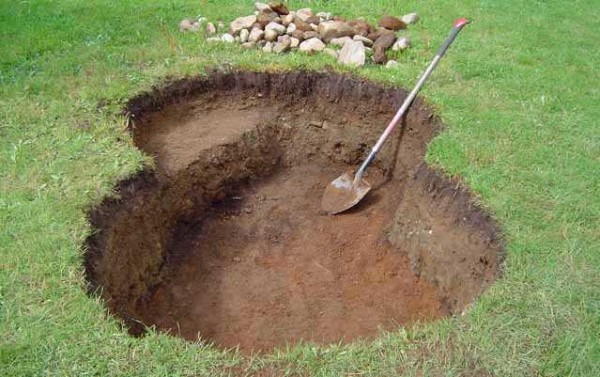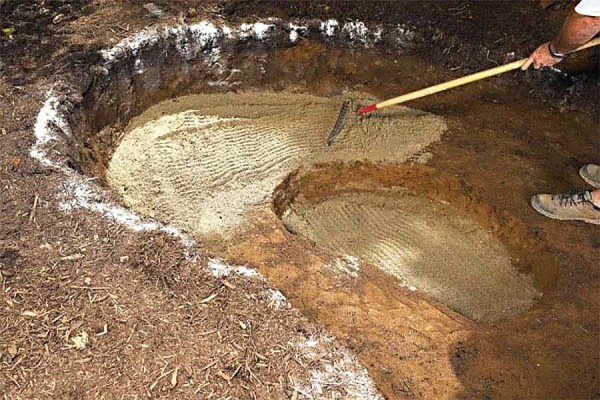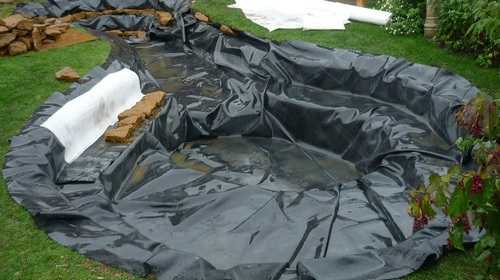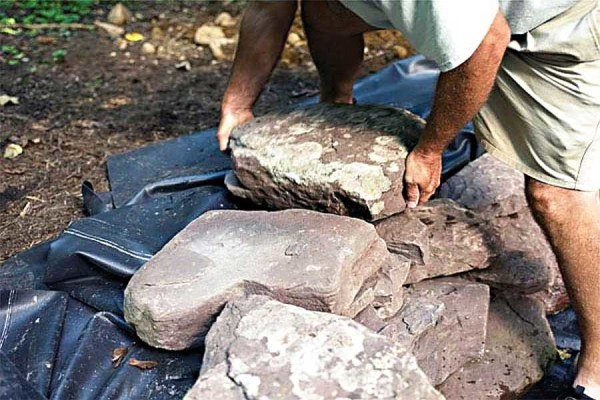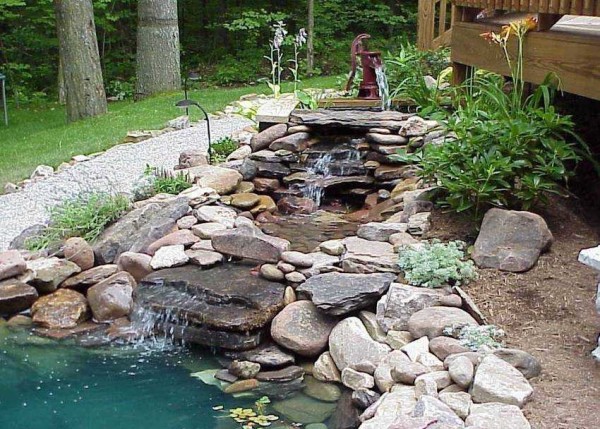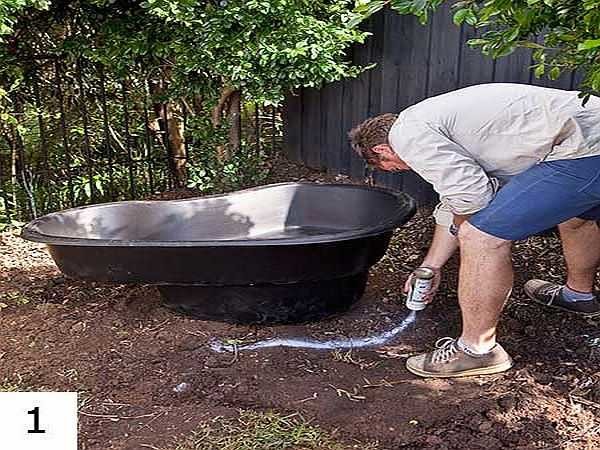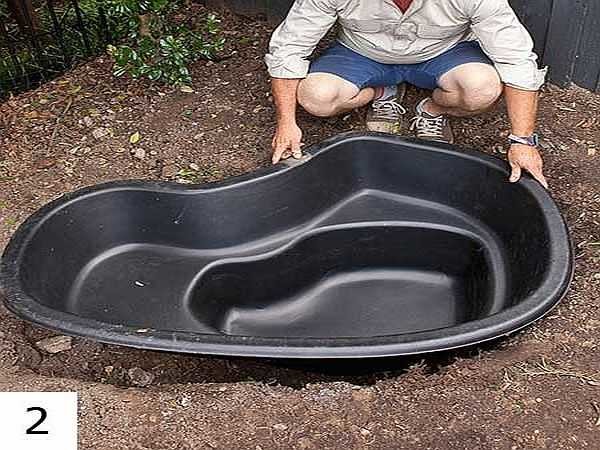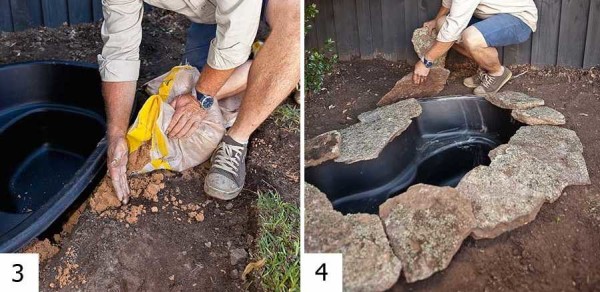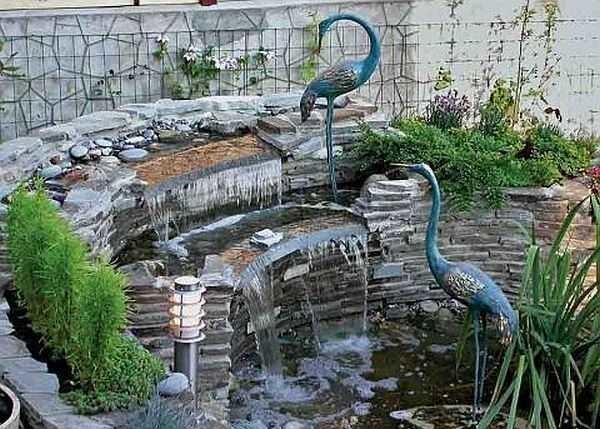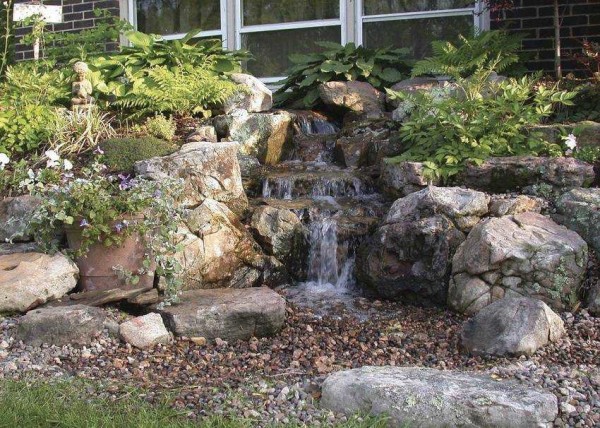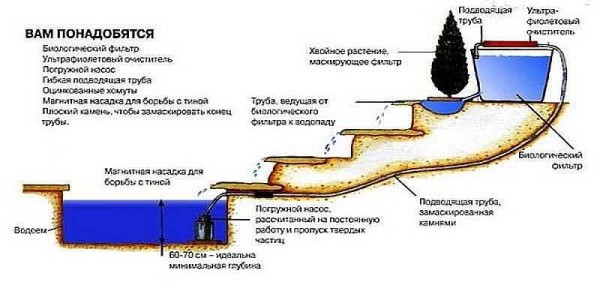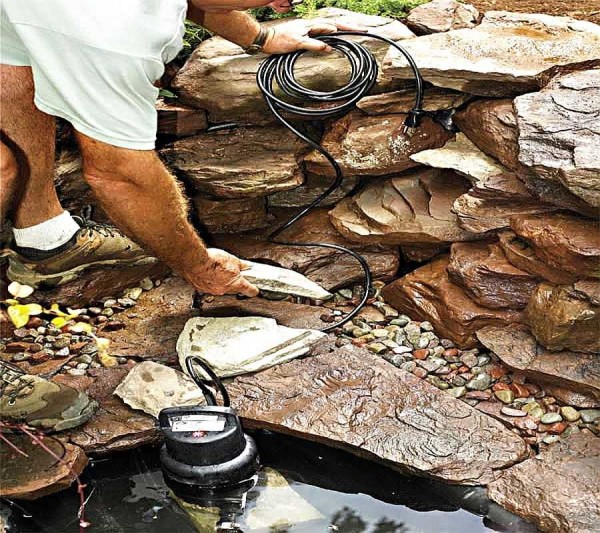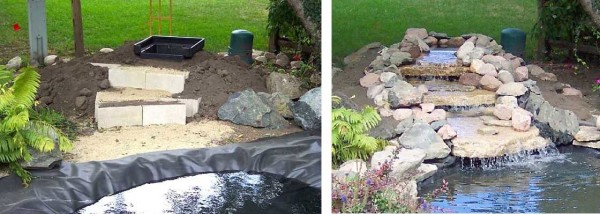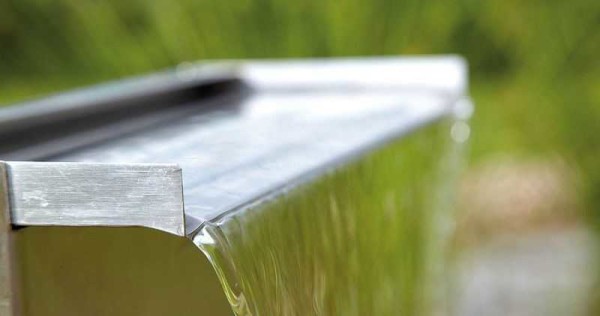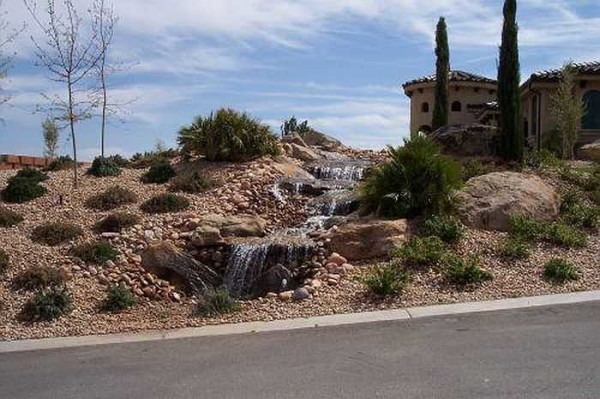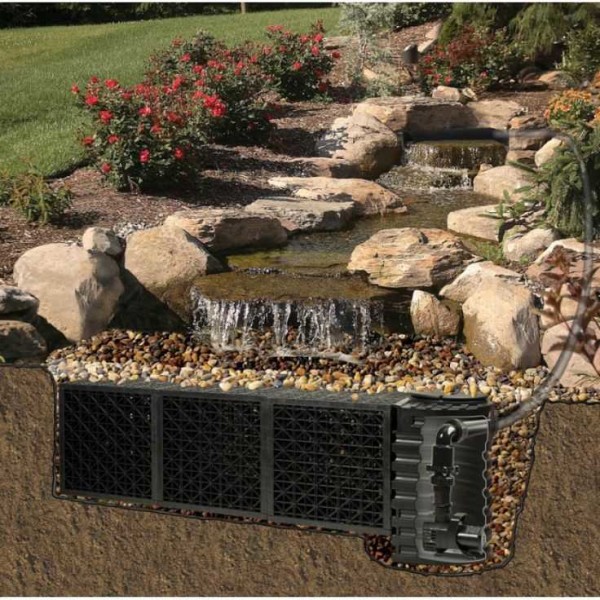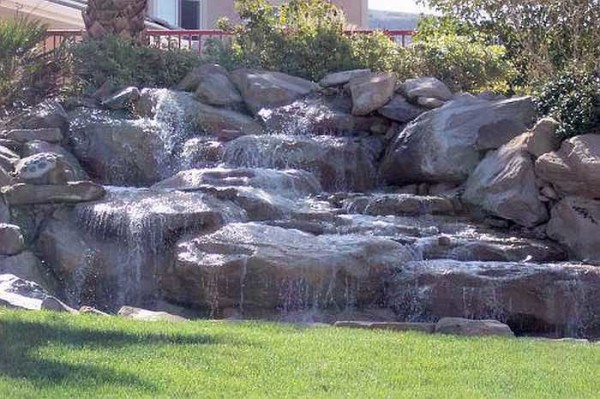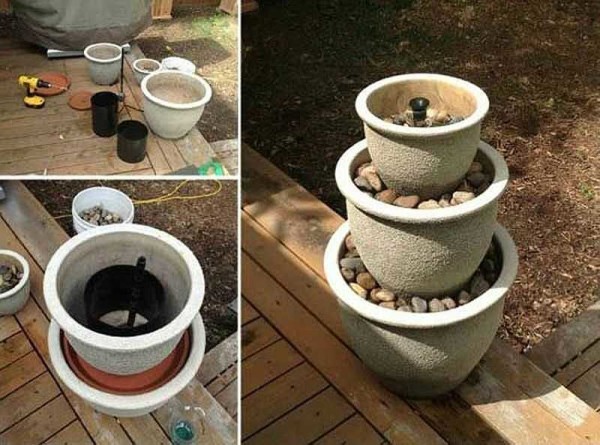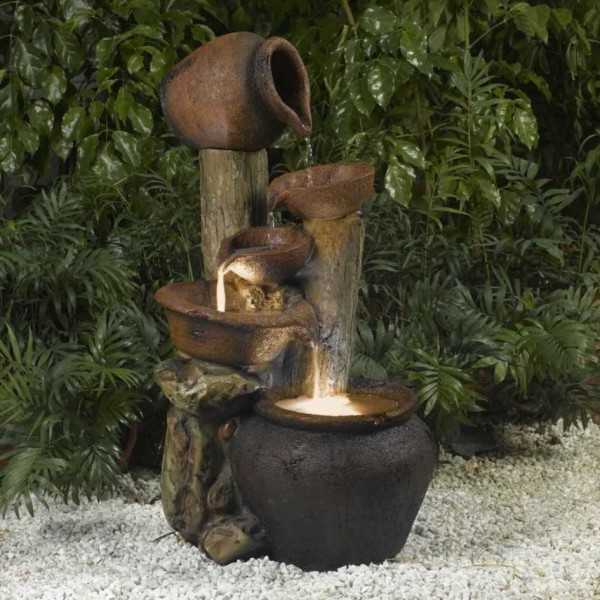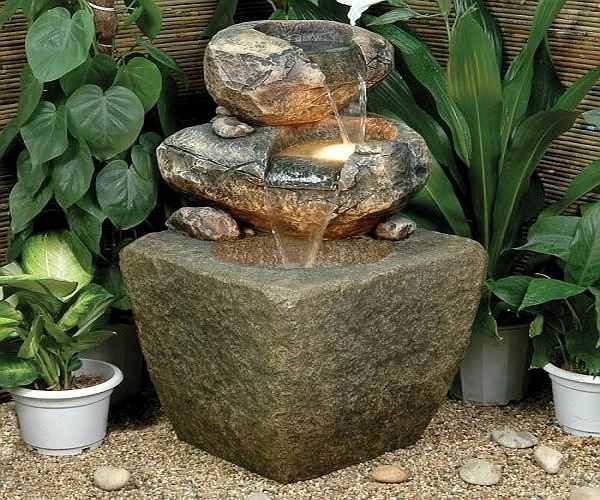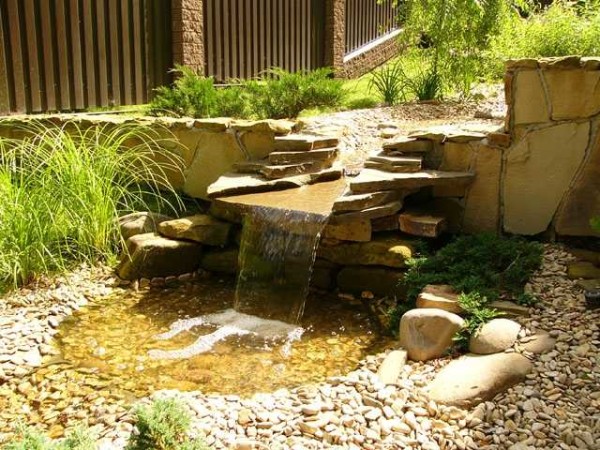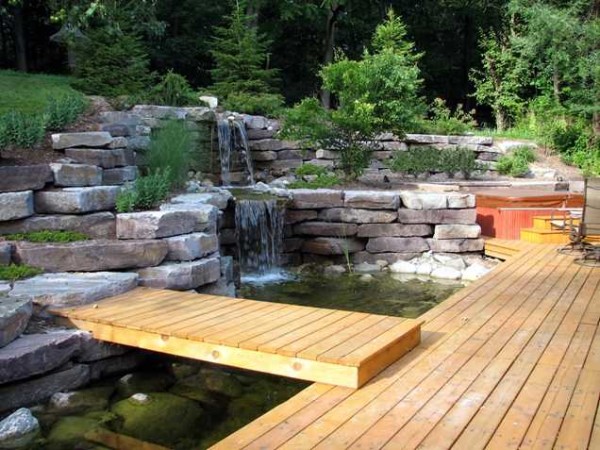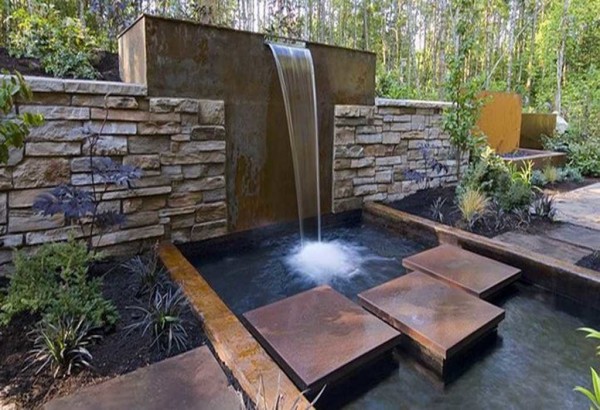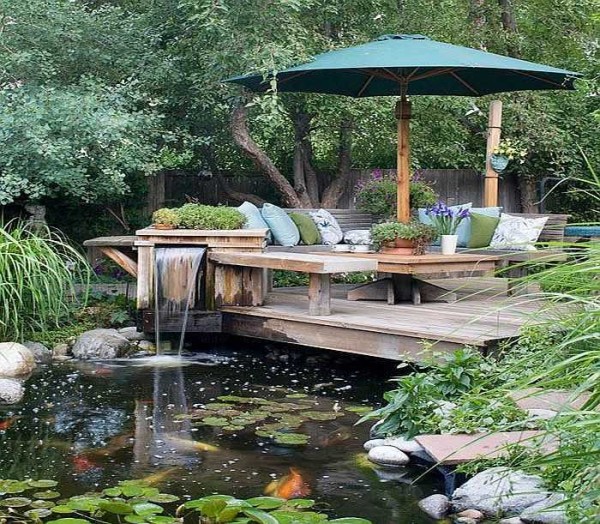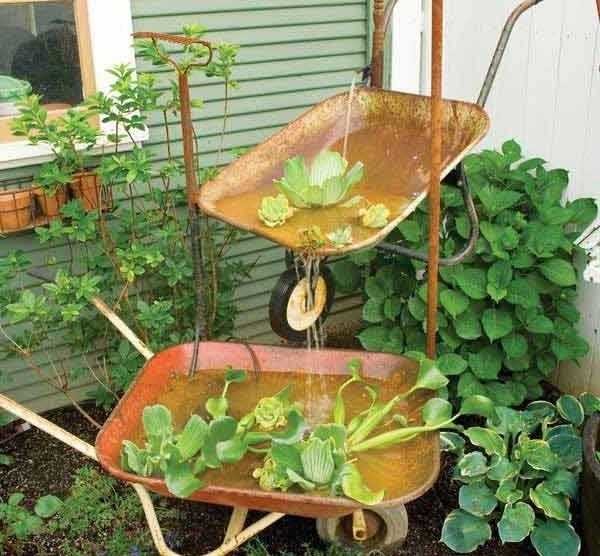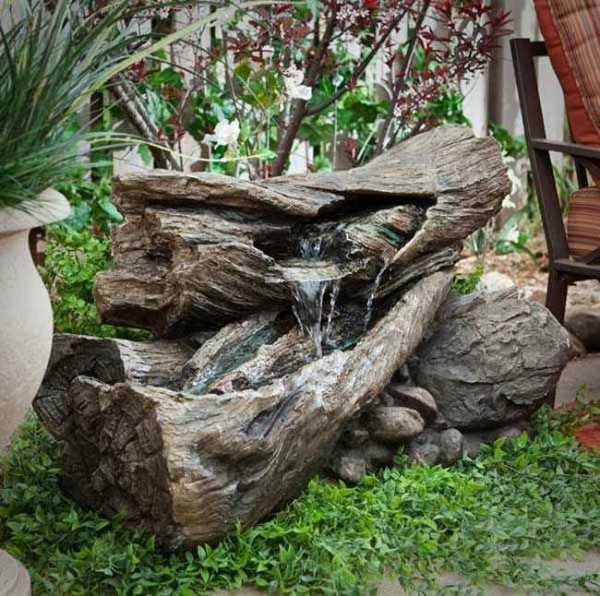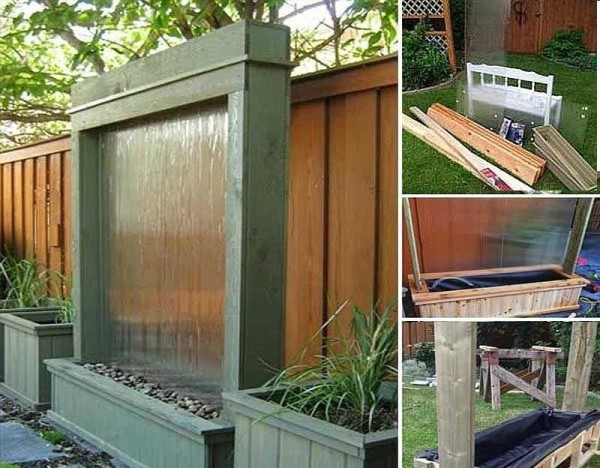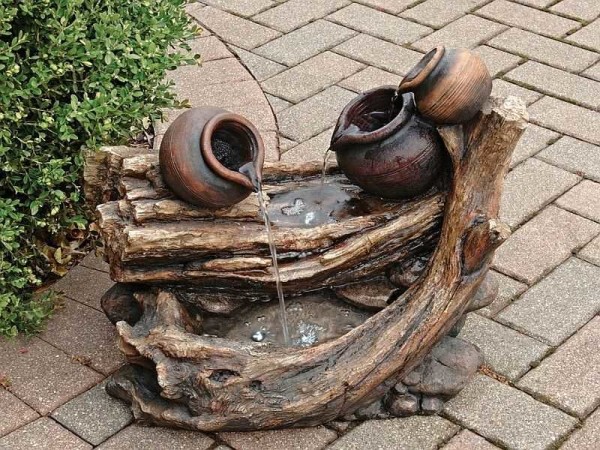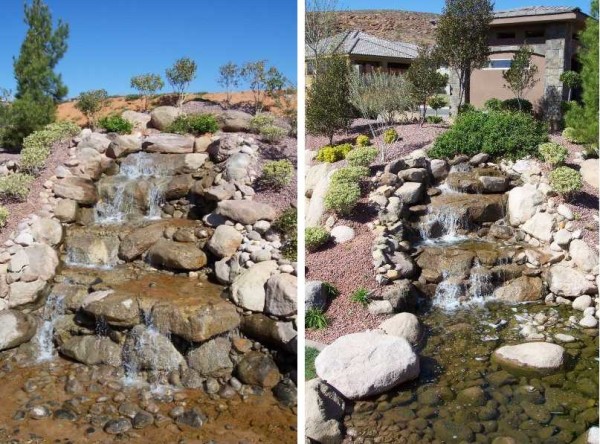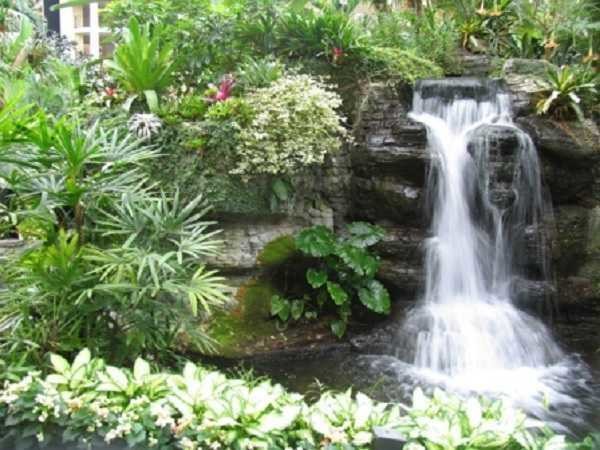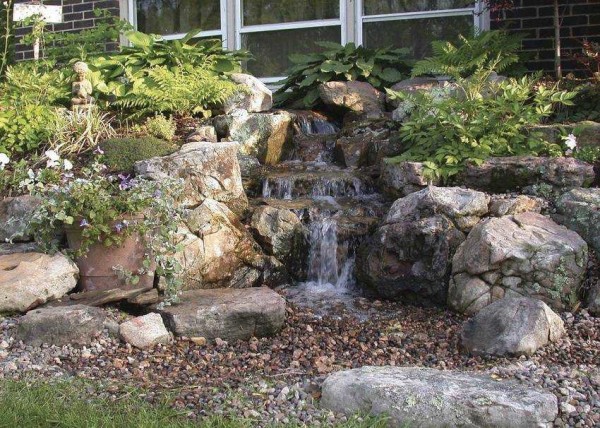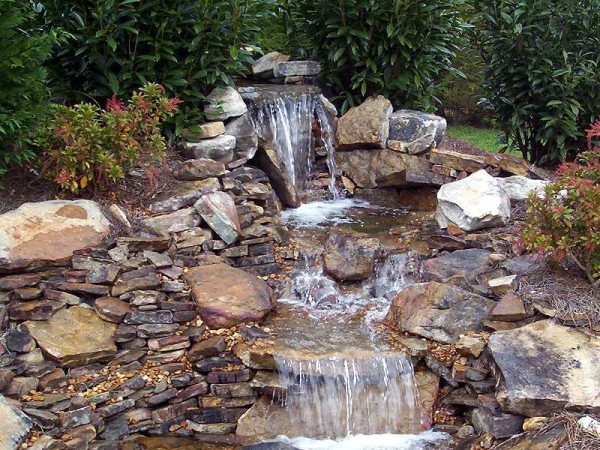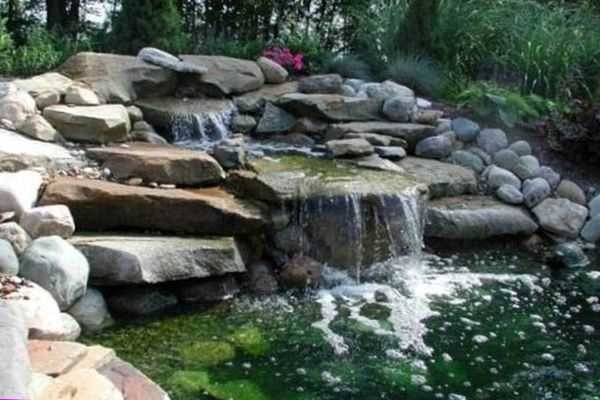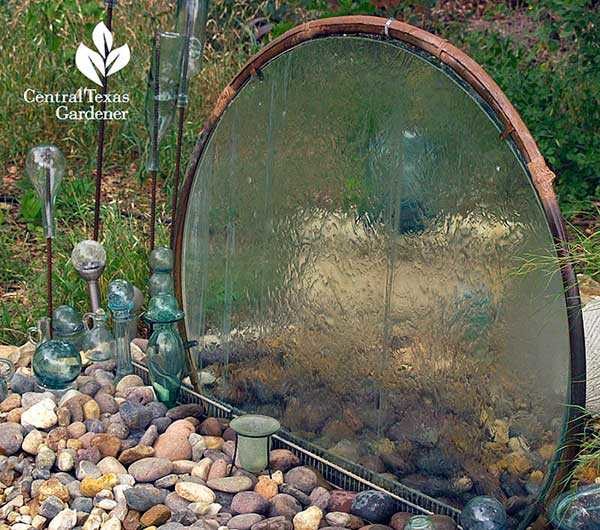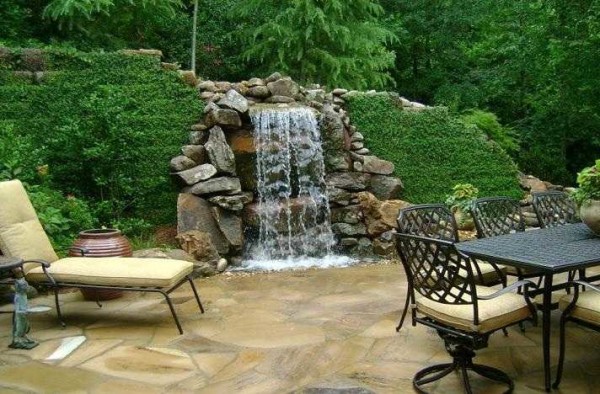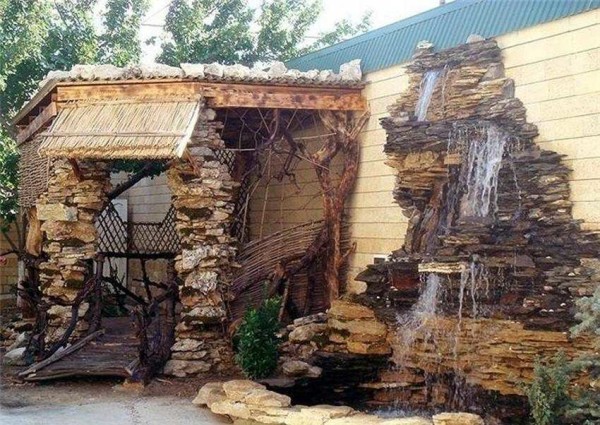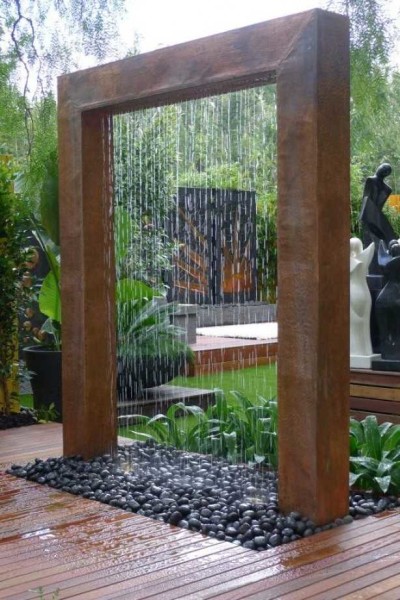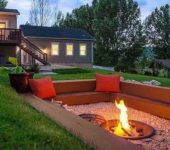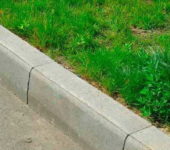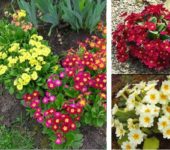How to make a waterfall for a summer residence and a house
Registration of a site is rarely complete without a reservoir. Water soothes and brings coolness on a hot day. It is also good that you can make a waterfall with your own hands, without involving specialists. It is important to have a pump and a place to turn it on. You can do the rest yourself.
The content of the article
Bowl
When building even a small waterfall with your own hands, you will have to throw a lot of land: it all starts with land work. It is necessary to dig a pit for the bowl in which the water will collect. Then the container must be sealed. There are two simple methods:
- Use film. If you plan to operate for a long time, you need a special film for pools and ponds (called a butyl rubber membrane). It costs a lot (for 1 square meter from $ 10), but it normally tolerates ultraviolet light and frost, it will serve for years. For a temporary, trial waterfall, a film that is used for greenhouses is suitable. Just note that it should be all-season with a service life of several years, not several seasons. This option is cheaper, but also much worse in performance.
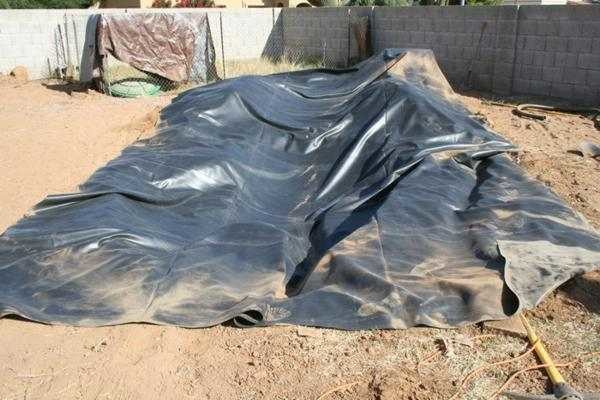
- Put on the plastic insert. They are also marketed as bowls for ponds and pools. They are relatively inexpensive - a container for 120-140 liters costs 1200-1500 rubles.
When using a ready-made bowl, you are limited in the choice of shape and depth: only those that are available. In the economy version - for a waterfall in the country - you can use any container available on the farm: an old bath or a bath. You can even adapt a barrel cut in half, etc.
Using the film, the shape, as well as the depth, you choose arbitrarily. But when working with the film, you need to be careful: although it is dense, it can be torn.
How to make a waterfall from film: photo report
First, mark on the ground the desired shape of your waterfall bowl. The shape depends on the style of your site. Strict geometric proportions are characteristic of the Art Nouveau style, they can be in Art Deco. In the rest, they try to give more natural, non-linear outlines. Most often, a pond in the form of a bean is obtained.
The easiest way to do the markings is with sand. It is poured into a bag, the corner is cut off. The waking up sand outline the contours. This makes it easier to assess how correct the shape you have chosen. If necessary, it can be corrected immediately.
Sod is removed along the contour, and then a pit is dug. Immediately, in the process of work, form ledges. The optimal depth of the reservoir is about a meter. How many sites you create at the same time, and what form they will be - depends only on your desire.
In the excavated pit, immediately remove all objects that can break the film: pebbles, pieces of roots, etc. The bottom, ledges, are leveled. The leveled soil is compacted. A rammer is used for this. In its simplest form, it is a piece of a tree trunk with a nailed plank. The deck is raised by the bar, then it is sharply lowered down. So the soil is compacted. Then a layer of sand is poured - 5-10 cm. It is leveled with a rake, spilled. Take medium-grained sand. It seals well with water. Otherwise, you will have to ram the sand.
You can immediately form a slide, if it is provided for in your waterfall. For example, such as in the photo below.
Next, the film is spread into the pit. It is desirable to spread under it geotextile (the cheapest - 600-700 rubles roll). This non-woven fabric will prevent root germination and redistribute the load more evenly. It is also laid on the edges of the pit, the sides and bottom are covered. Above is already a film.
As already mentioned, it is better to use a butyl rubber membrane. It can be ordered in any format and you will have a seamless fountain. The dimensions of the film are calculated simply: maximum width + doubled depth + 60-80 cm for a margin at the edges. If your waterfall is 2 * 3 m in size (at the most extreme points) and 1.2 m deep, then the film will be needed:
- 2 m wide + 2 * 1.2 m + 80 cm = 5.2 m
- 3 m long + 2 * 1.2 m = 0.8 m = 6.2 m
First spread it at the bottom, straighten it, forming folds. After leveling, press down with stones around the perimeter. Then you can proceed to alignment on ledges.
It is better to completely lay the ledges with stones. The bottom is also desirable, but pebbles and small boulders can be used. And the ledges are best decorated with layered stones. Although they are in the water, they are clearly visible. Although we make the waterfall artificial, we want it to look harmonious.
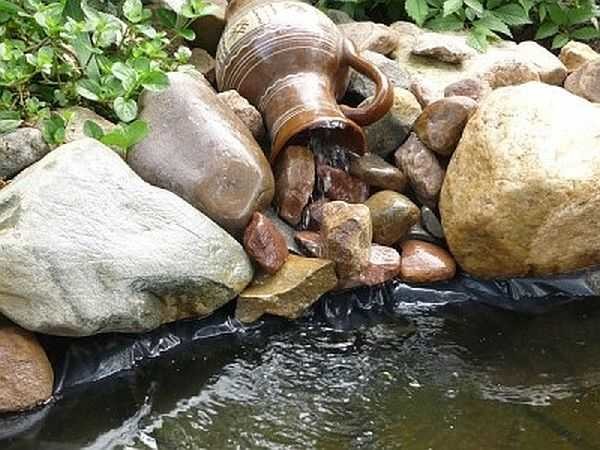
A common mistake when decorating a waterfall - the sides of the bowl are not lined with stone and the film spoils a good idea
By folding the boulders one by one, they can and should be fastened with mortar. You can use both large and medium or small stones. It all depends on the configuration and height of the steps. As a result, the slopes will be uneven, and also with ledges. It looks much better than transparent film. Such a homemade waterfall brings satisfaction to the owners.
The whole procedure for building a bowl, all technological and nuances completely coincide with the construction of a pond. About how and from what you can make it, read here.
How to install a plastic bowl
When building a waterfall with your own hands using a ready-made container, for a start, turning it upside down, outline the contours. A pit is being dug on them.
It should be slightly larger than the bowl. When working, they are guided by the existing shape, measuring ledges and forming similar contours. It is desirable to repeat the figured protrusions with a sufficiently high accuracy so that they find normal support.
The ledges and the bottom are leveled, tamped, poured a 5-10 cm layer of sand, leveled its layer, but do not spill or tamp: under the weight of the bowl, it will compact itself. Having installed the bowl, we notice that there is a gap between its wall and the wall of the pit. We also fill it with sand. But here, it is desirable to condense it. We'll have to do it with a pole or something like that. If the soil drains water well, you can spill the sand that has been poured.
If the container is plastic, with thin walls, and the volume is large, it is better to fill the gap with sand by filling it with water. This way, you won't be able to deform the walls by ramming the sand too hard.
After that, all that remains is the decoration of the board and the device of the slide, from which the water will, in fact, fall.
Read about the construction of fountains here.
How to make a slide for a waterfall
If you plan to decorate the edges of the waterfall with stones, and you want a high and large slide, along which water flows, you need a solid foundation - a reinforced platform. Without it, the stones will slide into the bowl. Near the pit under the bowl, a platform under the hill is cleared and reinforced.
Make a standard monolithic slab. First, they dig a pit. Its dimensions should exceed the slide by 40-50 cm in all directions. The pit is dug with a depth of 20-25 cm. Then the following order of work:
- Gravel is covered with a layer 10-15 cm thick, it is well rammed.
- Reinforcement with a diameter of 12-15 mm is laid. It is laid up and down with a step of 20 cm, at the intersection it is pulled together with plastic clamps.
- Pour in concrete.
After the concrete has set (after a couple of weeks), you can start laying out the slide. This procedure is necessary if the height of the slide above ground level is about one meter.
If the waterfall is planned to be small, you can simply remove the soil, pour crushed stone (you can lay geotextiles under it so that the crushed stone does not wash out into the ground). Tamp the crushed stone well, pour a little sand on top, lay out a metal mesh made of thick wire. Lay boulders on it, decorate with smaller stones, pebbles, sand, plant plants. It will turn out kind of flower slidewith a waterfall.
There is a second option - to make a cascade type waterfall, using the height difference on the site. Even a small slope of several degrees will make the task much easier: steps are formed on the slope, laying stones in the form of slabs. If there is no slope, you will have to fill in an earthen mound, carefully compacting each layer, not forgetting to form ledges. Polymer mesh can be used to reinforce slopes. It is spread out, covered with earth. It will keep the soil from slipping.
A film is spread on the formed ledges, which is pressed against the channel by stones. They need to be laid out so that water from this stone falls into another, and not onto the film. And then - it's up to the design
When forming a slide for a waterfall, stones between themselves, even if they are large, central, it is desirable to fasten it with a cement-sand mortar (for 1 part of Portland cement, 3 parts of sand and 0.5-0.7 water).
The planning and arrangement of the site is described in this article.
Installing the pump
A pump for a waterfall in a country house or on a site near a house is selected according to two parameters: the height to which it can raise water, and its performance.
With height, everything is more or less clear: it should be no less than the height difference in your homemade waterfall. The difference is measured from the lowest point of the tank (the pump will stand there) and to the point where it should raise it. In small home reservoirs, it rarely exceeds 1.5-2 meters. But, anyway, keep track of this indicator.
The pump capacity shows how much water it can pump per minute. The power of the stream depends on this indicator.
Submersible pumps are used in such reservoirs. They are placed on the bottom, placed in a basket with stones, or simply by crushing the body with a few boulders. It takes water from the container by feeding it into a hose that is attached to the outlet. Lay this hose to the place where the water will run from.
To be able to pull out the hose, a plastic pipe of a decent diameter is built into the slide. So that the rubber sleeve can be lowered into it without any problems.
Better to put the pump in the basket. It works well with clean water, and your waterfall may contain leaves, all kinds of midges, dust and other contaminants inevitably get there. And the basket, or rather, the box can be covered with several layers of filters of different density. At first - with a fine mesh, and the floor with something denser, at least the same geotextile. This filter will trap major contaminants.
After installing this equipment, filling it with water and starting it up, you can consider the waterfall built by your own hands. There remains such a "trifle" as the design of the banks.
How to make a flat flow
If you want there to be not a stream, but a wide stream of water, you will have to install another container on the top of the slide, but already rectangular. One edge should be lower than the other.
There are special containers, but you can make any of them by cutting off the edge and making a flat tray from which the water will flow like a wall.
Dry waterfall
You've probably already seen mysterious waterfalls without a bowl into which it falls.Flowing down the ledges, it disappears somewhere. This is not a pond with a waterfall. No reservoir is visible.
Of course, there is a container for collecting water. She's just disguised. It turns out a kind of "dry" waterfall. Making it, perhaps, is no more difficult than usual.
The capacity is also dug in: into the pit. Only from above it is covered with a metal mesh with a fine mesh (preferably made of stainless steel). If the dimensions of the container are large, you can put reinforcement rods or wooden bars on the sides as a basis (do not forget to soak so as not to rot).
A smaller one is spread on a metal mesh, a polymer one is also suitable. It will retain more or less large pollution. Small stones are placed on top to decorate this device. So it turns out that the water falls into the ground ...
Decorative waterfalls
There is not always a place for such a massive structure, a span of several meters. A small waterfall can be placed near benches, gazebos, in your favorite corner of the garden. Such decorative devices require very low-power pumps, such as aquarium pumps.
Any suitable container can be used as a housing. Up to ceramic and even plastic pots. They are stacked one on top of the other. The lower one must be sealed, but the upper ones depend on the design.
In the variant in the photo above, a small pump is placed in the lower, largest vessel. It is covered with a plastic cover. The diameter is selected so that the plastic becomes 3-5 cm below the edge and can be closed with small stones. Numerous holes are made in this cover (with a drill). They also make a hole in the middle for the tube that will go from the pump.
A similar hole is made in the center of the other two containers. They are assembled like a children's pyramid, and its center is a tube that goes from the pump. So that the structure does not turn out to be very heavy, a plastic liner is inserted into each of the pots. it is covered with small pebbles. Pour water into the resulting pyramid, turn on the pump. A small soda fountain is ready.
Moreover, this technology can be used to make small home waterfalls. For example, this one will look great on the balcony.
By the same principle, you can make waterfalls in a different way. The principle is the same: the same. We mask the pump in the largest container. We feed the tube or hose up.
Home Floor Glass Waterfall
The water running down the glass looks great in the interior. In modern apartments, the problem of dry air is relevant. And such a device is a great way to increase humidity without using humidifiers. It's easy to make such a waterfall with your own hands. The design is simple, looks great. We need a sealed pallet. You can find some kind of plastic container. Make a frame in size, inside which, on one side, pass the tube from the pump. In the upper part, the tube is attached to the frame, and numerous holes are made in it.
Saturate wooden elements with tinted wood oil. It perfectly protects against dampness and gives an excellent appearance.
You can make a similar installation sealed. The job is a little more difficult, but also doable. It is necessary to make the frame wider, with the possibility of fixing the second glass. First, one glass panel is mounted, the hoses are laid, and after a test run, a second glass can be installed. Tightness is achieved with a sealant. Just take neutral silicone (acrylic turns yellow quickly).

